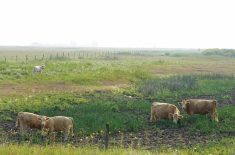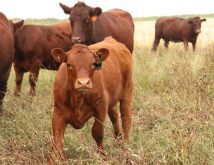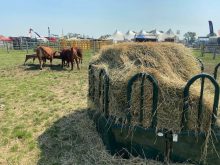More rural municipalities and counties that saw drought or excess moisture last year have been added to the federal list of areas where ranchers may now defer some of their 2014 taxable income.
The federal government on Thursday rolled out its final list of designated areas for the 2014 tax year, adding to an already-long initial list released at the end of December.
“Extreme” weather conditions in 2014, which included drought in British Columbia and Alberta and excess moisture in Saskatchewan and Manitoba, led to “significant” forage shortages across the West and some producers having to reduce breeding herds, the government said.
Read Also

JBS profit falls amid still-challenging US market environment
JBS, the world’s largest meat company, reported a net profit fall in the third quarter in spite of a rise in global net sales amid a still-challenging beef market environment in the U.S., according to an earnings statement on Thursday.
The list of drought-affected areas, attached below, so far includes 32 census subdivisions in B.C., up by one (Peace River B) from December, plus seven counties and six municipal districts in Alberta, up from four and five in December respectively.
The list of areas hit with excess moisture — also attached below — now includes 66 municipalities, one First Nation and two census subdivisions in western and central Manitoba, up from 27 municipalities and one First Nation in December. The excess moisture list now also includes 49 RMs in Saskatchewan, up from 22 in December.
In those designated areas, eligible producers who sold breeding livestock may be allowed to defer some or most of the income tax on those sales for one year. Proceeds from deferred sales are included as income in the next tax year, to be “at least partially offset” by the cost of buying breeding animals.
Eligible producers will be able to request the tax deferral when filing their 2014 income tax returns.
To qualify, a producer’s breeding herd must have been reduced by at least 15 per cent, from which 30 per cent of income from net sales can then be deferred.
Where a herd has been reduced by more than 30 per cent, 90 per cent of income from eligible net sales can be deferred.
Producers in areas that get consecutive years of drought or excess moisture/flood designation will be able to defer sales income to the first year in which their areas are no longer designated. No areas were designated during 2013.
A federal agriculture minister may call on the Canada Revenue Agency to allow such tax deferrals when impact is deemed “significant” — that is, where forage yields in a given year are less than 50 per cent of the long-term average, across an area large enough to have an impact on the industry.
Preliminary designations can be made “if it appears that the criteria will be met.” Final decisions and adjustments are made on designations when all forage yield information is available. Typically, preliminary designations and final adjustments are made in September and December respectively. — AGCanada.com Network
Livestock tax deferral designated regions, 2014
British Columbia (drought): Census subdivisions Alberni-Clayoquot (A, C, D), Bulkley-Nechako (A through G), Capital (F and H (Part 2)), Cariboo (A, B, C, I), Comox Valley (A), Cowichan Valley (F), Fraser-Fort George (A, C through H), Nanaimo (C, H), Peace River (B through E) and Powell River (D).
Alberta (drought): Birch Hills County, Clear Hills County, Grande Prairie County No. 1, Mackenzie County No. 23, Northern Lights County No. 22, Northern Sunrise County, Saddle Hills County; municipal districts of Big Lakes, Fairview, Greenview, Peace, Smoky River and Spirit River.
Saskatchewan (excessive moisture): Rural municipalities of Antler, Argyle, Buchanan, Calder, Cana, Churchbridge, Clayton, Cote, Elfros, Emerald, Enniskillen, Fertile Belt, Foam Lake, Garry, Good Lake, Grayson, Hazel Dell, Insinger, Invermay, Ituna Bon Accord, Kelvington, Keys, Lakeview, Langenburg, Livingston, Martin, Maryfield, McLeod, Moose Creek, Moose Mountain, Moosomin, Mount Pleasant, Orkney, Ponass Lake, Preeceville, Reciprocity, Rocanville, Saltcoats, Sasman, Silverwood. Sliding Hills, Spy Hill, St. Philips, Stanley, Storthoaks, Wallace, Walpole, Wawken and Willowdale.
Manitoba (excessive moisture): Census subdivisions No. 17 and No. 20 (South Part); Valley River First Nation 63A; Municipality of Shoal Lake; rural municipalities of Archie, Arthur, Birtle, Blanshard, Brenda, Cameron, Clanwilliam, Coldwell, Daly, Dauphin, Edward, Ellice, Elton, Eriksdale, Ethelbert, Gilbert Plains, Glenella, Glenwood, Grahamdale, Grandview, Hamiota, Harrison, Hillsburg, Killarney-Turtle Mountain, Lakeview, Langford, Lansdowne, Lawrence, McCreary, Minitonas, Miniota, Minto, Morton, Mossey River, Mountain, North Cypress, North Norfolk, Oakland, Odanah, Ochre River, Park, Pipestone, Portage la Prairie, Riverside, Rosedale, Rossburn, Russell, Saskatchewan, Shell River, Shellmouth-Boulton, Sifton, Siglunes, Silver Creek, South Cypress, St. Laurent, Ste. Rose, Strathclair, Swan River, Wallace, Westbourne, Whitehead, Whitewater, Winchester, Woodlands and Woodworth.














